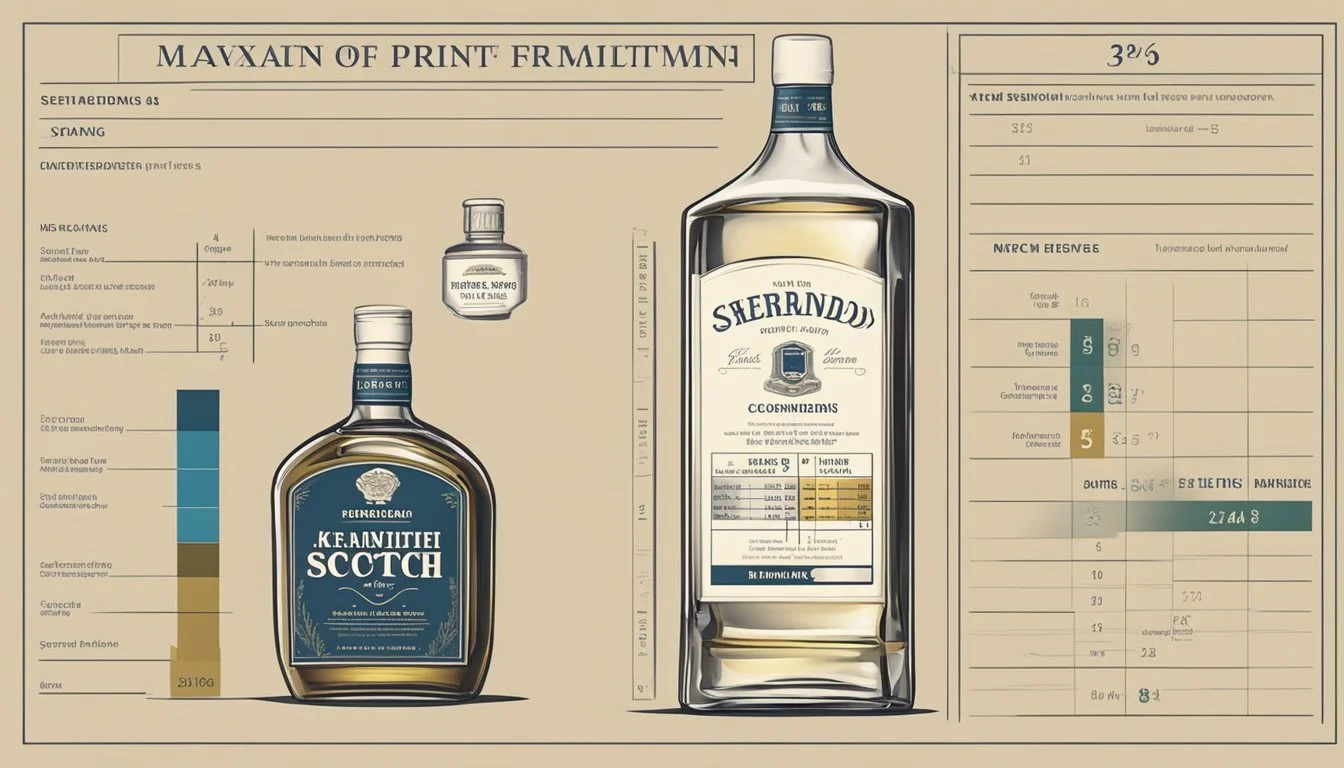How Many Servings of Scotch is Too Much
Understanding Safe Consumption
Determining how much Scotch is too much can be critical for maintaining both your enjoyment and your health. According to the U.S. Dietary Guidelines, moderation is key: for women, this means limiting consumption to one drink or less per day, and for men, two drinks or less per day. Exceeding these limits can lead to health risks, including liver damage and increased blood pressure.
A standard drink of Scotch typically contains about 1.5 ounces of 40% alcohol by volume. Regularly drinking more than the recommended amounts can contribute to alcohol dependency and negatively impact overall well-being. Light to moderate alcohol consumption may offer some health benefits, such as increased antioxidants, but these must be weighed against potential risks.
Crafting a balanced perspective is essential. Whisky enthusiasts should consider both the joys of occasional indulgence and the necessity of adhering to health guidelines to optimize the benefits while minimizing the risks.
Understanding Standard Drinks
Recognizing what constitutes a standard drink helps in determining how many servings of Scotch or any other alcoholic beverage might be too much. Comparing Scotch to beer and wine illustrates differences in alcohol content and serving sizes.
Definition of a Standard Drink
A standard drink in the United States is any beverage that contains roughly 14 grams of pure alcohol. This amount of alcohol is typically found in:
12 ounces of regular beer (about 5% alcohol)
5 ounces of wine (about 12% alcohol)
1.5 ounces of distilled spirits (40% alcohol, e.g., 80-proof liquor)
These measurements standardize how we understand drinking to aid in managing intake and ensuring safe consumption levels.
Scotch as a Standard Drink
Scotch is a type of distilled spirit, usually consumed in smaller quantities due to its higher alcohol content. One standard drink of Scotch is typically 1.5 ounces, containing the same 14 grams of pure alcohol.
Single-malt Scotch and other types of Scotch whiskies often contain about 40% alcohol by volume (ABV), aligning them with the standard drink measurements of other spirits. Consequently, this well-defined measure assists in setting limits on consumption.
Comparing Scotch to Beer and Wine
To understand how many servings of Scotch might be too much, comparing it to beer and wine is helpful. Here's a comparison:
Beer: 12 ounces at 5% ABV is one standard drink.
Wine: 5 ounces at 12% ABV is one standard drink.
Scotch: 1.5 ounces at 40% ABV is one standard drink.
Craft beers can sometimes have higher alcohol contents, up to 8-9%, altering the standard drink calculation. Meanwhile, malt liquor, light beer, and cocktails vary significantly in alcohol content and serving size. This solid framework for understanding standard drinks provides clarity for individuals looking to moderate their intake responsibly.
Alcohol Consumption Guidelines
Guidelines for alcohol consumption vary widely, taking into account factors like gender, age, and health conditions. Understanding these factors can help individuals make informed decisions about their alcohol intake.
General Guidelines per Gender
For men, the U.S. Dietary Guidelines suggest limiting alcohol consumption to 2 drinks or less per day. For women, the recommendation is 1 drink or less per day. The National Institute on Alcohol Abuse and Alcoholism describes a standard drink as 1.5 ounces of distilled spirits, such as Scotch. Binge drinking for men is defined as consuming 5 or more drinks in about 2 hours, and for women, it is 4 or more drinks.
Impact of Age on Alcohol Consumption
Age significantly impacts alcohol consumption. The legal drinking age in the U.S. is 21. Young adults, especially under 25, should be cautious due to ongoing brain development. Older adults metabolize alcohol more slowly, increasing the risk of intoxication and health complications. Individuals over 65 should generally limit their intake to 1 drink per day, as per CDC recommendations.
National and International Standards
The Centers for Disease Control and Prevention and the National Institute on Alcohol Abuse and Alcoholism provide clear guidelines. In the U.S., moderate drinking is up to 1 drink per day for women and 2 for men. The World Health Organization advises similar limits and emphasizes the dangers of heavy and binge drinking. Always consult local guidelines, as standards can vary by country.
Using these guidelines, individuals can better understand what constitutes moderate, binge, or heavy drinking and make informed choices based on their health and circumstances.
Health Implications of Excessive Drinking
Excessive alcohol consumption poses serious short-term and long-term health risks. From immediate dangers like accidents and acute poisoning to chronic conditions, the impact on health can be extensive and severe.
Short-Term Health Risks
Excessive drinking can result in acute health issues. These include memory blackouts, falls, burns, and accidents due to impaired motor skills and judgment.
Violence, including homicide and suicide, can be exacerbated by excessive drinking. Acute alcohol toxicity can lead to alcohol poisoning, which raises the risk of coma or death. High blood pressure can also spike temporarily, placing stress on the cardiovascular system and potentially leading to heart problems.
Long-Term Health Effects
Chronic excessive drinking has devastating longer-term consequences. Persistent alcohol consumption leads to liver disease such as cirrhosis and liver cancer.
It increases the risk of cardiovascular disease, high blood pressure, and stroke. Mental health suffers as well, with heightened risks of depression and dementia. There’s also a higher mortality rate due to these chronic conditions.
Specific Ailments Related to Alcohol Abuse
Alcohol abuse elevates the likelihood of various specific ailments. Continuous heavy drinking is closely linked to several types of cancer including mouth, throat, esophagus, liver, and breast cancers.
Repeated episodes of gastritis and stomach ulcers occur due to stomach lining inflammation. There’s also a high risk of developing fatty liver and cirrhosis. Pregnant people who drink excessively risk severe fetal development issues including Fetal Alcohol Spectrum Disorders (FASD).
Using formatting properly, such as bold for key terms, ensures important points stand out for the reader.
When to Seek Professional Advice
It's critical to consult healthcare professionals when experiencing unusual symptoms due to alcohol consumption, determining your risk for alcohol use disorder (AUD), or assessing personal drinking habits to safeguard long-term health.
Consulting Healthcare Professionals
Individuals should consult a doctor if they experience negative reactions after consuming Scotch or any other alcohol. This includes persistent dizziness, rapid heartbeat, or severe headaches.
Those with existing medical conditions or taking medications that might interact with alcohol should also seek medical advice. A doctor can provide tailored advice on safe alcohol consumption limits and potential health conditions exacerbated by drinking.
Health professionals can also offer guidance if there is a family history of alcohol-related issues, helping to gauge personal risks associated with drinking.
Recognizing Alcohol Use Disorder (AUD)
Recognizing Alcohol Use Disorder (AUD) is crucial for understanding when professional intervention is necessary. Signs of AUD include drinking more than intended, unsuccessful attempts to cut down, or cravings for alcohol.
It also encompasses spending significant time obtaining, drinking, or recovering from alcohol use. Reporting these symptoms to a healthcare provider can lead to a diagnosis and treatment plan.
People should seek professional help if alcohol consumption is affecting their responsibilities, social interactions, or health, as early intervention can prevent further complications.
Assessing Personal Drinking Habits
Self-assessment is key in determining when to seek advice. Those frequently drinking on an empty stomach or combining alcohol with mixed drinks should evaluate the impact on their health.
Monitoring the quantity and frequency of Scotch intake and noting any adverse effects can help in understanding personal limits.
If uncertain about safe drinking levels, health professionals can offer assessments and advice tailored to individual health profiles.
Asking for expert guidance is especially important for those who may be at risk due to their overall health or medications they are taking.
Regular check-ins with a doctor ensure that alcohol consumption remains within safe limits, promoting long-term well-being.
Responsible Drinking Practices
Responsible drinking involves understanding personal limits, incorporating alcohol in a balanced diet, and avoiding high-risk situations. Practicing these principles enhances health and well-being while mitigating risks associated with alcohol consumption.
Determining Personal Limits
Determining personal limits is crucial for responsible drinking. Various guidelines suggest that moderate drinking may involve up to one standard drink per day for women and up to two for men.
A standard drink typically contains 14 grams of pure alcohol, equivalent to one 5-ounce glass of wine, 12 ounces of beer, or 1.5 ounces of distilled spirits like Scotch. Knowing these measurements helps individuals gauge their intake accurately.
Recognizing signs of alcohol use disorder, such as cravings, loss of control, and withdrawal symptoms, can also aid in identifying personal limits. Consulting healthcare providers for personalized advice further supports responsible drinking practices.
Incorporating Alcohol in a Healthy Diet
Incorporating alcohol into a healthy diet requires balance and mindfulness. Alcohol, while containing calories, lacks essential nutrients and can contribute to weight gain if consumed excessively.
When drinking, opting for lower-calorie options such as light beer or wine can mitigate caloric intake. Pairing alcohol with nutritious foods like lean proteins, whole grains, and vegetables supports overall health.
Staying hydrated by drinking water alongside alcoholic beverages helps maintain hydration and can reduce the likelihood of overconsumption. Following national guidelines regarding alcohol intake ensures that drinking remains a part of a healthy lifestyle rather than a detriment.
Avoiding High-Risk Drinking Situations
Avoiding high-risk drinking situations is essential to maintaining responsible habits. High-risk scenarios include binge drinking, drinking and driving, and consuming alcohol in unsafe environments.
Binge drinking is defined as consuming four or more drinks for women and five or more for men within two hours. This behavior significantly increases the risk of accidents and health issues.
Designating a driver or using public transportation can prevent driving under the influence. Avoiding situations where alcohol is a primary focus, such as certain parties or events, also helps reduce temptation. Establishing clear boundaries and making informed choices reinforces safe drinking practices.
Support and Resources for Drinking Moderately
Moderate drinking involves understanding your limits and having access to the right resources. Various support groups, educational materials, and community support can assist individuals in managing their alcohol consumption effectively.
Utilizing Support Groups
Support groups are valuable for individuals seeking to drink moderately. Alcoholics Anonymous (AA) is one prominent example, providing a structured program and a supportive community.
Groups like Self-Management and Recovery Training (SMART Recovery) offer tools based on scientific research. These groups can help address the psychological aspects of alcohol use disorder (AUD).
Regular meetings and peer support are crucial. They foster a sense of accountability and community, helping individuals stay committed to their goals.
Educational Materials and Programs
Educational resources provide essential information on the impacts of alcohol and strategies for moderate consumption. The U.S. Department of Agriculture's Dietary Guidelines offer insights into healthy drinking limits.
Programs like Rethinking Drinking, offered by the National Institute on Alcohol Abuse and Alcoholism, guide individuals in evaluating their drinking patterns and making informed decisions.
Including alcohol education in regular health classes or workplace seminars can also raise awareness. These programs focus on the risks of excessive drinking, such as heart disease, liver damage, and brain impairments.
Finding Community and Professional Support
Connecting with community resources can be beneficial. Local health departments often offer alcohol education and counseling services. Professional counselors or therapists specializing in alcohol use can provide personalized support.
Physicians can screen for AUD and recommend appropriate treatments. Community centers may also host workshops or provide referrals to professional resources.
In addition, hotlines and online forums offer immediate assistance for those seeking help. These resources ensure that support is available whenever needed.
Diversified support systems, whether community-based or professional, can greatly enhance an individual's ability to maintain moderation in drinking habits.






